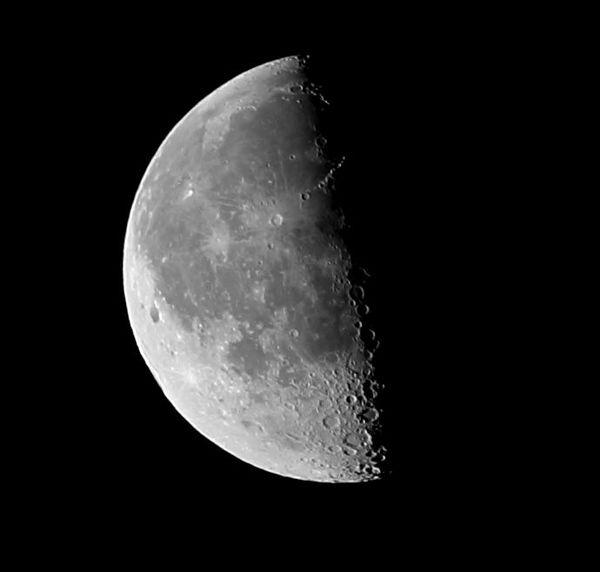Bright white ball!
Nov 12, 2016 23:53:40 #
Just shoot in live view and start adjusting to see the detail. I made a decent shot at ISO 100 1/320 second at F5.6 @ 300 mm on a crop body. Just keep working the exposure above and below, almost like manual bracketing and find a shot you like. Remember you're actually shooting an image illuminated by direct sunlight. The loony 11 works but I'd prefer to shoot at faster shutter speeds to ensure sharp shots.
Nov 13, 2016 03:27:41 #
Pablo8
Loc: Nottingham UK.
I have used 1/100 @ f/11 on 100asa.and got detail using focal lengths from 400mm to 640mm. Even a higher shutter speed and/or f/16 if very clear night. Using 800asa 1/125 @f/5.6. is a formula for just getting a Super White Ball . Try it if you like wasting your time!!
Nov 13, 2016 03:35:48 #
Nov 13, 2016 06:02:49 #
SharpShooter wrote:
Once, when talking to a Canon tech, he said, "you don't use the 10/10/10 rule"? I said, "what the heck is that"?
It's really easy, ISO 100, SS 100, f10. It's almost exactly what you said but only with about a 1000 less numbers and words!!! LoL
SS
It's really easy, ISO 100, SS 100, f10. It's almost exactly what you said but only with about a 1000 less numbers and words!!! LoL
SS
That's pretty easy to reminder, and I like easy!
Thanks
Nov 13, 2016 06:34:46 #
Haydon wrote:
Just shoot in live view and start adjusting to see the detail. I made a decent shot at ISO 100 1/320 second at F5.6 @ 300 mm on a crop body. Just keep working the exposure above and below, almost like manual bracketing and find a shot you like. Remember you're actually shooting an image illuminated by direct sunlight. The loony 11 works but I'd prefer to shoot at faster shutter speeds to ensure sharp shots.
Thanks Hayden.
Nov 13, 2016 06:35:25 #
Pablo8 wrote:
I have used 1/100 @ f/11 on 100asa.and got detail using focal lengths from 400mm to 640mm. Even a higher shutter speed and/or f/16 if very clear night. Using 800asa 1/125 @f/5.6. is a formula for just getting a Super White Ball . Try it if you like wasting your time!!
Thank you Pablo.
Nov 13, 2016 07:06:05 #
Cookie223 wrote:
I know I'm doing something wrong. I've been trying... (show quote)
I shoot with a Nikon df , I use shutter priority ,iso 600. speed 1/500, starting point, I do not use a tripod unless I am going to want to have a sharp for ground and a sharp moon by staking and blending in photo shop. I don't shot the full moon, full moons the edges are soft, waxing and weaning moons give the best details.
Nov 13, 2016 07:25:19 #
Nov 13, 2016 07:31:59 #
Cookie223 wrote:
I know I'm doing something wrong. I've been trying... (show quote)
Spot metering
ISO 100
f/whatever is sharpest for a given lens...try f/8
Adjust shutter speed as needed. As was suggested earlier, try f/125. That depends largely on how clear your sky is.
I focus mine manually using LiveView at the 10x setting. If yours autofocuses correctly, that will be fine, too.
Here's an example:
f/8
ISO 100
1/60th
Tamron 70-300mm @300mm
Nov 13, 2016 07:36:49 #
Jackh wrote:
I've been trying ("rehearsing") in manua... (show quote)
Lots of tips online. It's very smart of you to be practicing ahead of time.
Nov 13, 2016 07:47:41 #
Shoeless_Photographer wrote:
Spot metering
ISO 100
f/whatever is sharpest for a given lens...try f/8
Adjust shutter speed as needed. As was suggested earlier, try f/125. That depends largely on how clear your sky is.
I focus mine manually using LiveView at the 10x setting. If yours autofocuses correctly, that will be fine, too.
Here's an example:
f/8
ISO 100
1/60th
Tamron 70-300mm @300mm
ISO 100
f/whatever is sharpest for a given lens...try f/8
Adjust shutter speed as needed. As was suggested earlier, try f/125. That depends largely on how clear your sky is.
I focus mine manually using LiveView at the 10x setting. If yours autofocuses correctly, that will be fine, too.
Here's an example:
f/8
ISO 100
1/60th
Tamron 70-300mm @300mm
That's a nice shot Shoeless. I'm going to be busy tonight trying out all the great suggestions you folks are providing. One thing that didn't work well was my autofocus, my camera couldn't make up it's mind, and kept going in and out of focus.
Thanks
Nov 13, 2016 07:50:56 #
Try setting your "exposure compensation" to minus 3. Your camera is looking at a black sky and trying to make it 18 percent grey. It does that by letting in more light and thus blowing out the moon.
Nov 13, 2016 08:06:59 #
Leitz
Loc: Solms
Cookie223 wrote:
... I've tried every setting on my camera, and get a bright white ball with no detail what so ever.
You're over-exposing. A spot meter reading of the brightest part of the moon will give you a starting point. Select a high enough shutter speed to avoid camera vibration, then adjust ISO and aperture accordingly. Try to avoid noise from a too-high ISO, and diffraction from a too-small aperture. Good luck!
The experts on Astronomical Photography hang out in the Astronomical Photography Forum:
http://www.uglyhedgehog.com/s-109-1.html
Nov 13, 2016 08:13:33 #
To make it even simpler. The moon is in full sunlight. Use exactly the same shutter speed, f stop, and ISO as you would at midday on a sunny day.
Nov 13, 2016 08:21:21 #
Dan De Lion wrote:
To make it even simpler. The moon is in full sunlight. Use exactly the same shutter speed, f stop, and ISO as you would at midday on a sunny day.
Thanks Dan.
If you want to reply, then register here. Registration is free and your account is created instantly, so you can post right away.






